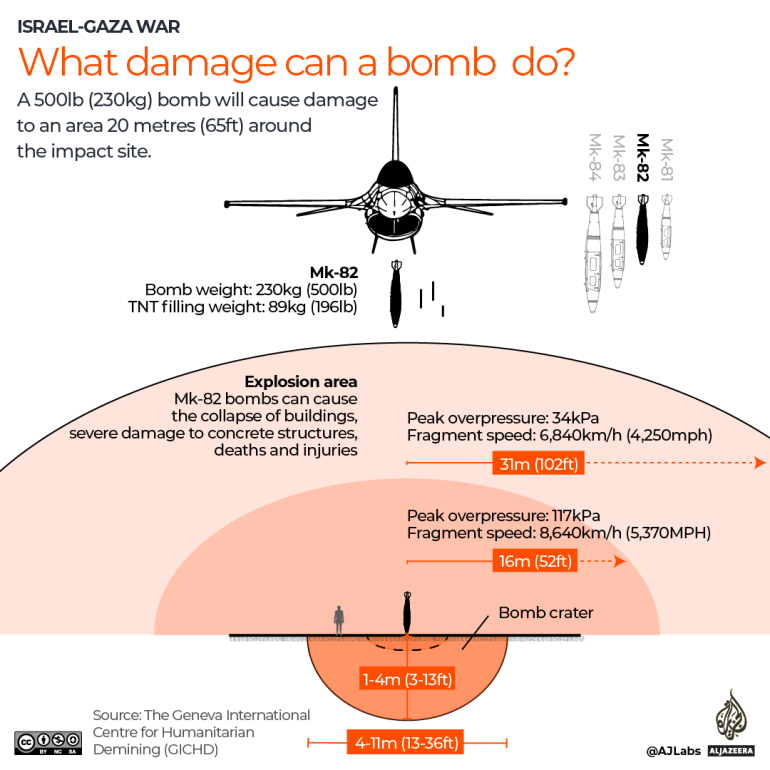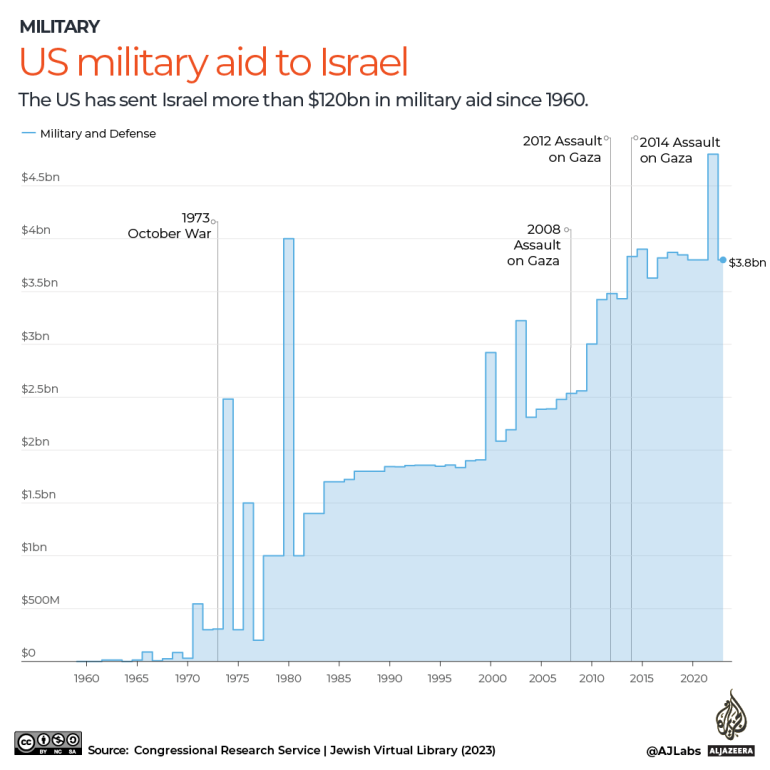The United States has stopped sending some types of heavy bombs to Israel and US President Joe Biden has also pledged to stop sending some offensive weapons and artillery shells to the country if it continues its attack on Gaza’s southernmost city, Rafah.
Here’s what we know so far.
What does the USA say?
Biden made this potentially harshest warning against Israel in an interview with CNN on Wednesday. In the same interview, he also said that the US would continue to supply defensive weapons such as Iron Dome interceptors, underscoring his continued support for Israel’s defense.
US officials said on Wednesday that the US had stopped a shipment of heavy bombs, including 1,800 2,000-pound bombs (907 kg) and 1,700 500-pound bombs (227 kg).
The Washington-based news agency Politico reported that the withheld weapons included Boeing’s Joint Direct Attack Munitions, which are guidance kits that convert “dumb” bombs dropped in free fall with a ballistic trajectory into precision-guided bombs.
These weapons were included in a previous shipment for Israel, approved before the additional aid package recently approved by the US Congress in April, which provided $26.38 billion for Israel, including $9.1 billion for humanitarian purposes .
At a U.S. Senate hearing on Wednesday, Defense Secretary Lloyd Austin said the U.S. is exploring short-term security assistance to Israel in light of ongoing Israeli attacks on Rafah.
“We have been clear from the outset that Israel should not launch a major attack on Rafah without considering and protecting civilians in this combat zone,” Austin said.
What damage can heavy bombs cause?
When exploded, a 500-pound bomb can seriously injure or kill anyone and everyone within a 20-meter (65-foot) radius. A 2,000-pound bomb has a destruction radius of 35 meters (115 feet), according to the Project on Defense Alternatives (PDA), which conducts defense policy research and analysis.
Depending on the type of surfaces it hits, a 500-pound bomb can create a crater with an average diameter of 25 feet (7.6 meters) and a depth of 8.5 feet (2.6 meters). According to the PDA, a 2,000-pound bomb will leave a crater 50 feet (15 meters) in diameter and 16 feet (5 meters) high.
A 2015 report from the Office of the UN High Commissioner for Human Rights (OHCHR) said of the 2,000-pound bomb: “The pressure from the explosion can rupture lungs, burst sinuses and tear off limbs hundreds of meters from the blast site.” ”
Israeli forces used 2,000-pound bombs on the Jabalia refugee camp on October 31, according to an analysis by The Guardian and The New York Times. Two impact craters with an estimated width of 40 feet (12 meters) were identified.

Is it legal for Israel to use these bombs in Gaza?
Air strikes on densely populated areas are not explicitly illegal under international humanitarian law. However, civilians cannot be the target of the bombing and any civilian casualties must be “proportionate” to a specific military target. Both Additional Protocol I to the 1949 Geneva Conventions and the 1907 Hague Convention lay down these rules. Israel is a signatory to both agreements.
If the number of civilian casualties is disproportionate and “clearly excessive” compared to any direct military advantage, then the attack is considered a war crime under the statute of the International Criminal Court, which is investigating Israel’s war on Gaza.
How did Israel react to Biden’s statement about offensive arms deliveries?
Israel claims its only interest is the destruction of Hamas and that it does not target Palestinian civilians. It claims to take all precautions to avoid unnecessary losses. It justified its attack on Rafah by claiming that the city was home to the remaining Hamas battalions. However, more than a million civilians have sought refuge there from Israeli bombardment of other parts of the Gaza Strip in the last seven months.
On Thursday, Gilad Erdan, Israel’s ambassador to the United Nations, told Israeli public radio Kan: “This is a difficult and very disappointing statement from a president to whom we have been grateful since the beginning of the war.”
Erdan said Biden’s warning would strengthen the positions of Iran, Hamas and Hezbollah.
“If Israel is prevented from entering an area as important and central as Rafah, where thousands of terrorists, hostages and Hamas leaders are located, then how exactly are we supposed to achieve our objectives?” he said.
How much military aid is the US giving to Israel?
The U.S. sends Israel about $3 billion a year, most of which is provided as Foreign Military Financing (FMF).
The United States has provided significant foreign aid to Israel in the past; According to the US Agency for International Aid (USAID), spending between 1946 and 2023 totaled $297 billion (adjusted for inflation), including $216 billion in military aid and $81 billion in economic aid. Israel is the largest cumulative recipient of American aid since its founding.
After the Hamas attack on October 7, the US sent naval vessels such as guided missile cruisers with naval guns and destroyers and ammunition worth $2 billion to Israel.

Israel is dependent on US military aid because of a global ammunition shortage as a result of the wars in Gaza and Ukraine, Israeli business daily The Calcalist reported, adding that the Israeli military has avoided publicly admitting how Maj. Gen. Eliezer Toledano admitted in March that the army was reducing airstrikes to “better manage arms economics.”
Has the US ever suspended military aid to Israel?
Yes. The United States ended its military aid to Israel in 1982 when then-President Ronald Reagan imposed a six-year ban on the sale of cluster weapons to Israel. This followed a congressional investigation that found that Israel had used the weapons in areas with civilian populations during its 1982 invasion of Lebanon.
What is happening in Rafah?
Israel launched a military offensive against Rafah on Tuesday and seized control of the Gaza side of the Rafah border crossing with Egypt, cutting off access to humanitarian aid, hours after Hamas agreed to a ceasefire deal. A nighttime attack on the area by warplanes followed, killing at least twelve civilians.
Following Israel’s relentless bombardment of the Gaza Strip since the war began on October 7, more than a million internally displaced Palestinians have sought refuge in Rafah – many of whom had previously been displaced from other parts of the Gaza Strip following Israel’s order to evacuate those areas had received. Over the course of the war, more than 34,000 Palestinians were killed, most of them women and children. Thousands more are missing and are feared dead under the rubble.
Since Rafah is Gaza’s southernmost city, observers say civilians now have nowhere else to go.
